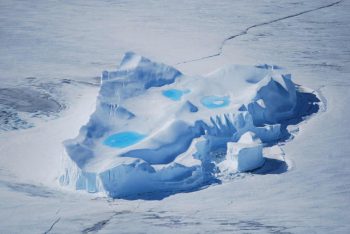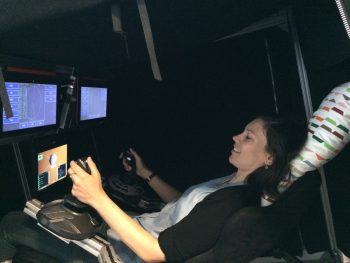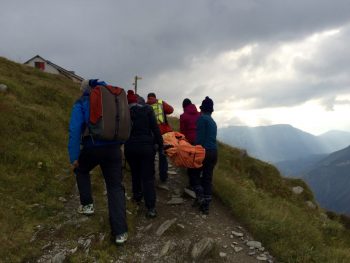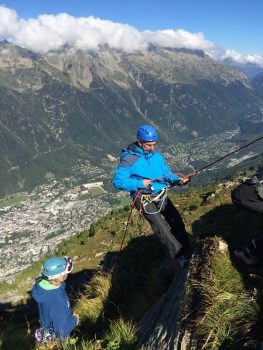Dr. Carole Dangoisse is this year’s ESA-sponsored medical doctor spending 12 months at Concordia research station in Antarctica. She is facilitating a number of experiments on the effects of isolation, light deprivation, and extreme temperatures on the human body and mind. In the following post, she summarises some of the experiments as well as the training she received to prepare her for a year on the frozen continent.

Iceberg swimming pools. Credits: ESA/IPEV/PNRA–D. Schmitt
Learning the tricks of the job
The whirlwind of the various training started in mid-August 2016.
I first went to Munich to meet the team of CHO2ICE-II (Consequences of longterm-Confinement and Hypobaric HypOxia on Immunity in the antarctic Concordia Environment), led by Prof Alexander Choukèr at the Hospital of the University of Munich. This experiment focuses on the immune system response and (mal) adaptation to the stress winter-overers are exposed to.
We will be under harsh conditions: living at the equivalent of almost 3800 metres of altitude with hypobaric hypoxic conditions, in a desert of ice where the mean yearly temperature is -50°C; submitted to the polar night with almost no sunlight for 3 months, in complete isolation for 9 months with the impossibility to be flown out of the station for the vast majority of this time, and cohabiting within a multicultural group in a secluded place with limited autonomy of movement, with the psychological hardships that this can entail.
Many of these stressors are similar to those astronauts will be submitted to when going on deep space missions, for example to Mars. Concordia station therefore makes for a great space analogue. ESA is interested in identifying the novel and idiosyncratic health problems astronauts could experience before they even leave on such risky and inaugural missions, and more importantly look for efficient counter-measures to alleviate these effects. It would obviously be disastrous if astronauts became ill after months of travelling and whilst far away from earth, with limited communications and medical facilities.
The few days in Munich were intensive; I had a great lecture on immunity mechanisms and pathways, took not one but two blood draws from Prof Choukèr himself, and most importantly had to find my lab technician reflexes once again, whilst under scrutiny from the team.

Carole training on the Simskill program at the Institute of Space Systems at the University of Stuttgart. Credit: C. Dangoisse
By the end of August I then flew out to Stuttgart for training on the Simskill program at the Institute of Space Systems at the University of Stuttgart. The goal of Simskill is to test for any signs of degradation of high-performance skills in an environment such as Concordia, which can be poorly stimulating and become monotonous after months of routine. Again, this is similar to spending months on a spaceship whilst travelling through space. Would astronauts arriving to Mars risk losing their ability to perform such complex manoeuvres as landing a capsule, and could regular training help lessen these effects? Tackling 2 joysticks simultaneously to manoeuvre in all possible directions (6 degrees of freedom: throttle or up and down, front and back, left and right, roll, yaw and pitch) whilst learning about translational and rotational offset and velocities was not spontaneous at first, but it was definitely a lot of fun, and I earned my flying wings!
The last step of my scientific training took part mid-September in Berlin, at the Freie und Humboldt Universitaten zu Berlin. I learned about the Bone-Health study, which focuses on the mechanisms of neuromuscular function deterioration and bone loss. Various factors could explain this expected degradation. In Concordia, our physical activity outside will be limited by the extreme cold temperatures (as well as the hypoxia); most of our moves will be confined to the station itself. We risk developing deficiencies in vitamin D, not benefiting from exposure to sunlight for many months. Other deficiencies could arise from relying on frozen and dried food for a lengthy period. Finally, the stressful environment itself could have repercussions on bone and muscle systems via metabolic and hormonal pathways. I learnt about techniques quite novel to me, such as bioelectrical impedance, a muscular testing platform, or a simplified version of a scan. Once again, I took the opportunity to explore the city, all the while thinking that in a few months I would not have as much freedom to move around!
A special team of doctors

The team of doctors set off for survival training. Credit: C. Dangoisse

Learning how to evacuate in the event of an emergency. Credit: C. Dangoisse
After the part of the training specific to my post, I was then invited by Paul Laforêt from the TAAF (Terres Australes et Antarctiques Françaises) for a few training sessions with the doctors who would be deployed on the sub Antarctic islands and the Antarctic coastal station Dumont D’Urville. We all share the fact that we might have to perform rescue procedures in remote conditions, and we have to be autonomous for any medical situation that could arise over the period of a year. At Concordia, the situation is slightly different in that it is an Italian doctor who is responsible for the medical facilities, but in the event of an emergency, I would of course assist as much as possible.
We first met in the local hospital in Sallanches and drove to Chamonix. The next day we hiked up to the “Refuge du plan de l’Aiguille” where we stayed for the whole week. Every morning we had lectures on various subjects; TAAF, the various sub Antarctic islands and their outposts, Antarctica, the Marion Dufresnes and Astrolabe ships and most importantly the medical situations we were most likely to be confronted to. In the afternoon we went outdoors and did various simulation exercises, learnt about ropes, knots and pulley systems and took out the harnesses for a little climbing. We practised how to recover an injured person at the bottom of a cliff by hoisting them back up. I played the role of the victim for the final exercise, and almost regretted it a few times on the way up, constricted by various ropes and dangling on a spine board whilst my colleagues decided on the best route…. It was a great opportunity to realise that, in difficult conditions and with limited means, priorities can change and often the first thing to think of is evacuating the victim and getting them back indoors!
I met the whole team again in Caen the next week, for some practical surgical training for emergencies such as appendicitis or inserting external fixators for displaced bone fractures. This turned out to be a very good and much-needed revision of anatomy!
The training was definitely turning out to be a flurry around Europe; I had never taken so many planes and caught so many trains in such a short time!




Discussion: no comments